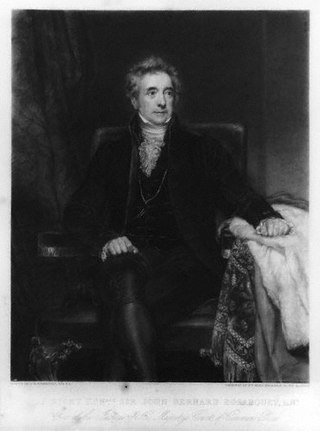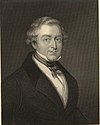
Henry Peter Brougham, 1st Baron Brougham and Vaux, was a British statesman who became Lord High Chancellor of Great Britain and played a prominent role in passing the Reform Act 1832 and Slavery Abolition Act 1833.

Charles Grey, 2nd Earl Grey, known as Viscount Howick between 1806 and 1807, was a British Whig politician who was Prime Minister of the United Kingdom from 1830 to 1834. He was a descendant of the House of Grey and the namesake of Earl Grey tea. Grey was a long-time leader of multiple reform movements. During his time as prime minister, his government brought about two notable reforms. The Reform Act 1832 enacted parliamentary reform, greatly increasing the electorate of the House of Commons.

William Wyndham Grenville, 1st Baron Grenville, was a British Pittite Tory politician who was Prime Minister of the United Kingdom from 1806 to 1807, but was a supporter of the Whigs for the duration of the Napoleonic Wars. As prime minister, his most significant achievement was the abolition of the slave trade in 1807. However, his government failed to either make peace with France or to accomplish Catholic emancipation and it was dismissed in the same year.

Frederick John Robinson, 1st Earl of Ripon,, styled The Honourable F. J. Robinson until 1827 and known between 1827 and 1833 as The Viscount Goderich, the name by which he is best known to history, was a British politician who served as Prime Minister of the United Kingdom from 1827 to 1828.

William George Spencer Cavendish, 6th Duke of Devonshire,, styled Marquess of Hartington until 1811, was an English peer, courtier and Whig politician. Known as the "Bachelor Duke", he served as Lord Chamberlain from 1827 to 1828 and again from 1830 to 1834. The Cavendish banana is named after him.

Dudley Ryder, 1st Earl of Harrowby, PC, FSA was a prominent British politician of the Pittite faction and the Tory party.

Thomas Spring Rice, 1st Baron Monteagle of Brandon, was a British Whig politician, who served as Chancellor of the Exchequer from 1835 to 1839.

Edward Burtenshaw Sugden, 1st Baron Saint Leonards, was a British lawyer, judge and Conservative politician.

Colonel James Archibald Stuart-Wortley-Mackenzie, 1st Baron Wharncliffe, PC was a British soldier and politician. A grandson of Prime Minister John Stuart, 3rd Earl of Bute, he held office under Sir Robert Peel as Lord Privy Seal between 1834 and 1835 and as Lord President of the Council between 1841 and 1845.

Thomas Denman, 1st Baron Denman, was an English lawyer, judge and politician. He served as Lord Chief Justice between 1832 and 1850.

George Howard, 6th Earl of Carlisle of Castle Howard,, styled Viscount Morpeth until 1825, was a British statesman. He served as Lord Privy Seal between 1827 and 1828 and in 1834 and was a member of Lord Grey's Whig government as Minister without Portfolio between 1830 and 1834.

Nathaniel Lindley, Baron Lindley, was an English judge.

Thomas Manners-Sutton, 1st Baron Manners, was a British lawyer and politician who served as Lord Chancellor of Ireland from 1807 to 1827.
William Hare, 2nd Earl of Listowel,, known as Viscount Ennismore from 1827 to 1837, was an Irish peer and politician.

Frederick William Hervey, 2nd Marquess of Bristol PC, FSA, styled Lord Hervey from 1803 to 1826 and Earl Jermyn from 1826 to 1859, was a British Tory politician. He served as Treasurer of the Household under Sir Robert Peel between 1841 and 1846.

Henry John Selwin-Ibbetson, 1st Baron Rookwood,, known as Sir Henry Selwin-Ibbetson, Bt, from 1869 to 1892, was a British Conservative politician. He served under Benjamin Disraeli as Under-Secretary of State for the Home Department between 1874 and 1878 and as Financial Secretary to the Treasury between 1878 and 1880.

John Stuart-Wortley, 2nd Baron Wharncliffe FRS, was a British Tory politician. He served briefly as Under-Secretary of State for War and the Colonies between December 1834 and January 1835.

Sir John Bernard Bosanquet KS PC was a British judge.

William Duncombe, 2nd Baron Feversham, was a British peer with a large estate in the North Riding of Yorkshire. He was prominent in the affairs of the Royal Agricultural Society and owner of a prize-winning herd of short-horn cattle. He served as a Tory Member of Parliament (MP) for the Riding from 1832 to 1841, after which he sat in the House of Lords, having succeeded to the title on the death of his father. From 1826 to 1831 he had sat as an Ultra-Tory MP. He was the first MP to support Richard Oastler's campaign for Factory Reform, and gave it unwavering support for the rest of his life; in 1847 he seconded the Second Reading in the Lords of the Factory Act of that year.
Vivian is the name of a British noble family of Cornish extraction that rose to wealth in various regions of the British Isles. Over time, several members of the Vivian family were made knights, baronets and peers. Hereditary titles held by the family include the Vivian barony as well as the Swansea barony. Several other members of the family have also risen to prominence.
























